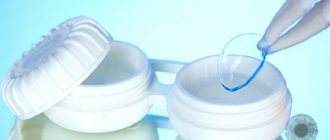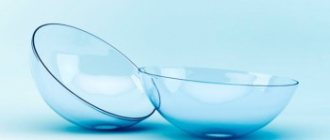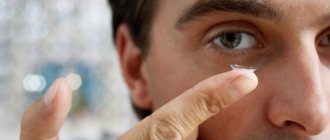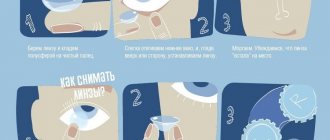The bulk of information from the outside world (more than 80%) comes to us through the eyes. The perception provided by the human eye allows the brain to evaluate all the characteristics of the object in question - volume, size, color. Deterioration of vision can be said to significantly worsen a person’s quality of life.
Until recently, the only option (non-surgical) to improve your vision was glasses. Today, ophthalmologists are increasingly suggesting that their patients abandon this optical device in favor of such an innovation as lenses (for 1 month, for a quarter, for 2 weeks, for a day - there are a lot of options).
Purpose of lenses and materials for their manufacture
Depending on the goals pursued, the ophthalmologist, after a thorough examination, will offer the best option for each individual patient. If a person just wants to look attractive and have an expressive look, then colored lenses are quite suitable for him. For a month, for 3 months, for a day - almost everyone can now change their appearance or add a certain zest to their image.
If a patient suffers from myopia or farsightedness and wants to eliminate these defects in visual perception, the ideal option for this case is spherical or aspherical lenses. The first is somewhat inferior in quality of image formation to the second, in which the optical power is the same in all areas. For those suffering from myopia and hypermetropia, this is the most correct solution.
Myopia and hypermetropia accompanied by astigmatism (disturbance in the shape of the lens or cornea) can be corrected with toric contact lenses. How long can you wear lenses? Prescribe them for a month, for 2 weeks or for another period of time - this will be decided by the attending ophthalmologist.
In addition, the modern medical market can offer patients means for correcting presbyopia (senile vision). The essence of the problem lies in the refractive error of the eye, in which a person cannot read text written in small print or see any small objects at close range. The most likely causes of the development of the disease are a decrease in the elasticity of the lens, a change in its curvature, and a weakening of the ciliary muscle that controls focus.
The materials from which contact lenses are made (for a month or for any other period) are hydrogel or silicone hydrogel. The second composition has qualities that are more attractive to consumers: it “breathes” better and does not require such intensive moisturizing as hydrogel. As a result, patients feel much more comfortable with contact correction products made from silicone hydrogel.
What happens if you don't remove your lenses for a week?
If they are overdue, the risk of developing:
- Hypoxia - oxygen starvation. This manifests itself in swelling and fatigue in the eyes. Subsequently, hypoxia can lead to the growth of blood vessels into the cornea and its clouding.
- Allergies. With constant contact of the conjunctiva with the material of the ophthalmic product, an allergic reaction may occur, which is accompanied by itching, burning, lacrimation and other symptoms.
- Infections. Lack of daily lens care often causes microbial keratitis and other infectious and inflammatory ophthalmic pathologies.
- Dry eye syndrome. Dryness of the cornea or connective membrane is a common sign of non-compliance with wearing contact lenses.
These diseases require long-term treatment, during which time you will have to abandon contact correction products. In addition, protein and lipid deposits get on the surface of ophthalmic products. If they are not removed, the optical properties of contact optics deteriorate. It will not provide high-quality images, which can lead to vision impairment. All these complications arise not only due to their overmaturity. It is also very dangerous to wear expired contact lenses.
Often, various eye diseases arise as a result of untimely replacement of optics.
Replacement frequency, possible modes of wearing lenses
The concept of replacement frequency refers to the maximum period of time for wearing correction products recommended by the manufacturer. After this period of time, the lenses must be replaced with new ones. According to this parameter they can be divided into:
- daily wear contact lenses,
- those that can be worn for 1 to 2 weeks,
- contact lenses for a month (without removing, they can be used for up to 30 days),
- There are also “optics” for long-term wear: from 3 months to six months and traditional lenses that can be used for 1 year.
Contact lenses that last from 6 to 12 months are packaged in special bottles.
For more frequent replacement, they are often packaged in blisters.
Wearing mode refers to the maximum time period during which vision correction products can be left in place. Thus, one group of lenses is intended for daytime use (put on in the morning and take off in the evening). The second includes long-lasting products (they are worn for a week and left on at night). Flexible wearing mode implies 1-2 days of use (without removing). Continuous use is when lenses are prescribed for a month. Without removing them, they can be worn for 30 days. True, this is only possible when using certain types of silicone hydrogel models, and they can only be used after consultation with an ophthalmologist.
Tips for caring for lenses
Proper and careful care of contact lenses is the key to eye health.
Monthly lenses, like all other types of contact optics, require cleaning and disinfection. Caring for them is not difficult, and it does not take much time.
Tips for caring for monthly lenses:
- Before starting any manipulations with contact lenses, you should wash your hands with soap and dry them with a towel.
- There should always be only clean and fresh solution in the container. Do not put lenses in the old solution several times in a row.
- You need to start putting on and taking off lenses from the same eye. This will prevent the lenses from being mixed up.
- After removing the lens, place it on your palm.
- Place a few drops of the solution on the lens and gently wipe the outer and inner surfaces with your fingertip.
- Then you need to rinse the lens with a couple more drops of disinfectant solution.
- Place the lens in a clean container and fill it with storage solution.
- Do similar manipulations with the other lens.
- Close the container with lids and leave the lenses overnight.
Read the material about which lenses are best to choose.
It should be remembered that the container where the lenses are stored must always be clean. If there is dirt there, it can get on the lenses. Therefore, after putting on a cleaned pair, you must always pour out the solution, and the container itself must be rinsed with a disinfectant solution and left to dry.
If monthly lenses are worn during the day, they should be removed and disinfected at night. This provides the eyes with rest at night, during which the lenses will be cleared of deposits and moisturized. And if the lenses have a prolonged action or are used continuously, then they do not have to be removed.
It should be noted that not all types of lenses can be worn and not removed for a whole month . There are continuous wear lenses that need to be removed after six days and cleaned afterwards. There are lenses that can be worn for thirty days and not removed. They do not require a special solution.
Lenses for long-term wear for planned replacement
If you take proper care of your lenses, there will be no discomfort. But if it appears, you need to check the lens for damage. Small cracks and scratches on its surface can irritate the eye. A damaged lens must be replaced. Discomfort may occur if a foreign body gets into the eye. The most common cause of discomfort is an inverted lens. Therefore, before putting on lenses, you need to place the lens on the pad of your index finger and look at it. If its edges are curved, then the lens has turned inside out.
Rating of the best lenses for glasses by clicking on the link.
What to do if your vision suddenly deteriorates?
How to treat astigmatism in children, read this article.
Long-term wear contact lenses: https://eyesdocs.ru/linzy/dlitelnogo-nosheniya/nepreryvnogo-nosheniya-vse-chto-vy-xoteli-znat.html
Breathable contact vision correction products
Contact lenses have a wide variety of characteristics. Among all the others, the packaging of contact vision correction products from any manufacturer contains the Dk/t marking. Dk denotes the oxygen permeability, t is the thickness of the lens at its center point. The ratio of these parameters to each other is called the oxygen transmittance coefficient. For hydrogel lenses this figure is 20-40 units, while for silicone hydrogel lenses it can range from 70 to 170 units. Therefore, contact correction products made from silicone hydrogel may well be called “Breathable Lenses” (for a month, quarter, two weeks or one day - it doesn’t matter).
Oxygen in such correction products is carried by the silicone component, which can rightfully be considered a kind of silicone pump. The amount of liquid in such lenses does not play such an important role as in simple hydrogel lenses, where oxygen permeability depends on the volume of water (more water means higher permeability). Therefore, when deciding the question (if you are choosing lenses for a month): “Which is better - hydrogel or silicone hydrogel?” preference should be given to the latter.
Benefits of monthly disposable lenses
Monthly lenses (which ones are better will be discussed below) are in wide demand among consumers. The advantages of these vision correction products over models with other wearing modes are as follows:
- Duration of wear, ideal combination of convenience and price;
— monthly contact lenses are produced in a wide range of optical powers (from + 6.0 to – 12.0 diopters), which allows covering a large group of consumers;
- products are produced with a variety of characteristics and properties: “breathable”, moisturizing, for insufficient corneal moisture, with increased biocompatibility, for use in low light conditions, with low formation of deposits, etc.;
— special lenses for 1 month have been developed for those suffering from astigmatism (multifocal);
— consumers are offered tinted and color-changing (colored) monthly lenses, which can be either with diopters or intended for people with normal vision (zero).
Use of contact lenses (per month)
There are two options worth considering here. The first is lenses with daytime wear. These products must be removed at night and stored in a special solution. During the night's sleep, the eyes will rest, and the lenses will be sufficiently moisturized, undergo special treatment (disinfection) and be cleaned of various deposits accumulated during the day. Such monthly lenses have the most positive reviews, but we must remember that a special solution and storage containers are mandatory conditions, if not met there is a risk of damage to the surface of the product and contamination. As a result, inflammation of the eyes occurs.
How to wear lenses (for a month - the standard prescription period) if they are of prolonged or continuous use? There are also some nuances here. Such vision correction products are not removed at night, but not all models can be worn continuously for 30 days. Some manufacturers answer the question of how long you can wear lenses per month, in the sense that they can be left on for 6 days. Then they are placed in a special cleaning solution for one night. And during this time your eyes will rest.
However, modern technologies are such that it has been possible to develop lenses that can be left on for an entire month. After this period, they are simply thrown away and replaced with new ones. For such models, you may not even need a special solution. The most popular products today include the following: Air Optix Night & Day, PureVision, PureVision 2 HD.
The manufacturer usually places information on how long you can wear lenses for a month without removing them at night on the packaging.
Now let's talk about which products are in greatest demand.
How to wear it correctly?
Monthly contact lenses can be daily or extended-wear. The first ones must be removed at night and stored in special containers with solution for contact lenses. Extended wear lenses can be worn for a month without removal. They don't need a solution.
Each lens is contained in an individual blister. The wearing period of 30 days is counted from the date of opening the blister.
For convenience, the lenses are lightly tinted and have a side indicator, which makes them easier to find in the solution. There are monthly lenses with a beginner-friendly shape that makes them easier to handle. This allows them to be removed and put on without damage, even for unadapted users. An ophthalmologist or contact specialist will give you competent recommendations on putting on, wearing, and storing lenses correctly.
Read about the degree of myopia in the material.
Leading-edge lenses designed for monthly use (daytime only)
There is such a thing as monthly lens leaders. Which ones are better? Products called MaximaSiHyPlus are in high consumer demand. Of all the options available that are designed for monthly replacement and removal at night, these products are one of the best. The material from which they are made is the latest generation silicone hydrogel. Good hydration, high oxygen permeability, resistance to deposits and biocompatibility provide the eye with the most comfortable conditions.
Another model of contact lenses that is in demand among the population is PureVision 2 HD. Of all those produced today, they are the thinnest. The high oxygen permeability coefficient (these are a kind of “breathable lenses” for a month) allows you to wear them for a week without removing them. PureVision 2 HD provides clear visual perception even in low light conditions without causing eye discomfort.
Acuview lenses (for a month) provide a person with an excellent level of comfort. Ultra-modern materials are used for their manufacture. A clear picture when working on a computer, watching TV, when in a room with dry air, excellent breathability guarantee comfort and safety to the eye.
Acuvue Oasys Extended Wear Lenses
Acuvue Oasys contact lenses are designed to last for two weeks. At the same time, the innovative production characteristics of this model allow for various periods of wearing - both daytime and flexible, prolonged, as well as nighttime. The unique structure of the material of these lenses allows the necessary amount of nutrients contained in oxygen to pass to the cornea of the eyes, even while you sleep. This model is perfect for beginners. According to ophthalmologists, Acuvue Oasys are, if not the best contact lenses, then certainly one of the best that can be recommended to new users for continuous wear. They are developed on the basis of Senofilkon A - a high-quality silicone hydrogel, which allows the development of optical products that are characterized by increased softness and elasticity.
In addition, this model is equipped with a filter that protects the visual organs from the negative effects of ultraviolet rays.
The best models for long-term wear
Among the models intended for continuous use, there are leaders - monthly contact lenses. Which ones are better? The product Air Optix Night & Day Aqua is in wide demand. The material used for their manufacture is silicone hydrogel. The optimal level of moisture content and high air permeability ensure comfort for the eyes throughout the entire wear period.
Biofifnity (CooperVision) contact lenses are also designed to be worn for a month (daytime only) or for continuous use for 2 weeks. The silicone hydrogel from which they are made has optimal air permeability and moisture content, which ensures eye safety and comfort throughout the entire period of use.
Air Optix Aqua long-wear contact lenses
Air Optix Aqua eye lenses are an equally high-quality model. Judging by reviews on the Internet, these ophthalmic products are not felt at all during use and do not require a long period of getting used to. They need to be replaced with new ones once a month, and the maintenance itself is quite simple. Thanks to their indicator color, they are clearly visible in solution, and their surface is highly resistant to the formation of protein and lipid deposits. Why do we think that this model is worthy of the title “The best contact lenses”? This is largely due to the presence of a unique Hydraglyde moisturizing matrix, which provides these wearing comfort with the required level of hydration throughout the entire period of use.
Acuvue contact lenses
One of the most popular non-surgical vision correction products on the medical market are Acuview Oasis lenses. In general, they are not designed for a month. The unique technology used to make the lenses combines two important aspects that protect the eye from inflammatory processes: moisturizing and continuous oxygen saturation.
It is no secret that many people now suffer from dry eye syndrome, the causes of which are rooms with low humidity, sitting for a long time at the computer, in front of the TV, etc. Previously, an ophthalmologist would not have been able to choose contact lenses for a patient with such a disease. Today the issue is resolved simply. Acuvue lenses (they are not intended for a month, and even without replacement, but two weeks is a completely acceptable period) are made with a special moisturizing component that continuously saturates the eyes with moisture. Although there are consumers who wear such lenses for a month, always removing them at night. By the end of 4 weeks, the product may become slightly cloudy (or may remain transparent).
Many patients find 1 Day ACUVUE TruEye daily contact lenses one of the most comfortable. For their manufacture, silicone hydrogel is used (usually hydrogel is used for one-day ones). The oxygen permeability of these contact vision correction devices is 100%. These lenses are so comfortable that they allow a person to forget “about their presence.”
The degree of oxygen permeability of these means of contact vision correction significantly exceeds that which is considered the norm for all others. Acuvue Oasis lenses (at least two sets are required per month) are equipped with a first-class UV filter, which reliably protects the retina and lens from B-rays (almost 100%) and from A-rays (up to 96%).
“Akuview Oasis” (for two weeks) or any contact lenses for a month (which is better is up to the consumer and the doctor to decide) should definitely be taken with you when going on vacation.
Why do you need contact lenses that you can sleep in?
In addition to the fact that lenses in which you can sleep are convenient to use for those people who do not have the opportunity to take care of them on a daily basis, the products are designed to correct severe degrees of visual pathologies. In the first case, the user does not need to wear them regularly; at any time he can switch to contact optics with daytime mode. It is only important to follow the rules of hygiene during rest, store the products in a special container with a solution, and also monitor the expiration date of contact lenses.
Thus, wearing them, as a rule, is prohibited after 30 days from the date of opening the package. You must carefully read the instructions supplied by the manufacturer. In the second case, when the patient is prescribed lenses that can be worn for a long time (without removing even during sleep), they correct vision, including at night, and also moisturize the cornea. Thus, people with dry eye syndrome receive round-the-clock hydration of the visual organs and do not experience discomfort during sleep.
In addition to soft silicone hydrogel lenses, there are hard ones. They are necessary to correct the shape of the cornea, which affects vision in myopia (myopia). After all, this refractive pathology is associated with an increased size of the eyeball.
The selection of contact optics of prolonged and flexible modes should be made exclusively by a qualified specialist after a comprehensive examination of the visual system. He will give important recommendations and write a prescription.
Quarter lenses
Quarterly lenses (for 3 months) are not considered by ophthalmologists and consumers to be the most optimal option for contact vision correction. Wearing products for such a long time requires appropriate attention (we are talking about very careful care). Today, people increasingly prefer lenses with a short service life (as they are more modern and comfortable, made from the latest materials).
For fans of long-term vision correction products, we can recommend the Precision UV product (CIBA Vision Corp). The material used for their production (hydrogel) blocks up to 91% of UV radiation harmful to the eyes. Such contact lenses are the best option for those who lead a fast-paced lifestyle and do not always have the opportunity to remove the devices.
What are the types of lenses based on wearing periods?
Modern ophthalmologists, contactologists and optometrists agree that the safest lenses are those with the shortest wear period. Products that are used for long periods of time can become a source of infection, reduce the quality of vision, and become uncomfortable due to deformation.
If any complications arise, the doctor always suggests changing the period of wearing lenses to a shorter one. This helps maintain eye health for a long time.
The wearing period reflects the number of calendar days of use after which the lens must be replaced with a new one. The wearing mode indicates the time that the lenses can be worn without removing.
Based on the wearing period, the following types of lenses are distinguished:
- one-day - replaced daily,
- frequent scheduled replacement - change to new ones after 7 days of continuous wear or after 14 days of daily wear,
- planned replacement - require replacement after 1–3 months (the period is determined by the manufacturer),
- traditional ones are used most rarely; they are replaced after six months or more.
There are the following modes of wearing SCL:
- daytime (DW) - lenses are removed while sleeping,
- flexible (FW) - continuous wearing is acceptable for up to 1–2 days,
- extended (EW) - lenses are used for up to 7 days continuously,
- long lasting (CW) - products are worn without removing for up to 30 days,
Opinion of consumers and ophthalmologists
So, is it possible to put on and wear lenses for a month without removing them? Reviews from ophthalmologists on this matter are mostly positive. If correction products are selected by a specialist taking into account the condition of the patient’s eyes, then they can be worn for 30 days, but you need to remember the date of the planned replacement and give your eyes a rest for at least one night. In the morning, you can safely put on a new set of long-term contact lenses. However, if the patient feels discomfort, the lenses should be removed immediately and consult a specialist.
As for consumers, the overwhelming number of people are satisfied with the effectiveness of these contact vision correction products. Lenses (any kind - daily, weekly, monthly, quarterly, etc.) are practically invisible from the outside, and vision becomes much sharper than when using glasses. To look to the side, a “bespectacled” person has to turn his head, while a person with contact lenses only needs to squint his eyes. Unlike glasses, lenses do not fall out during sudden movements and do not sweat when the ambient temperature suddenly changes. And in general, any kind of sport, active recreation, etc. is available to a person with lenses.
Of course, there are also disadvantages. Consumers say (and ophthalmologists confirm this) that if contact lenses are fitted incorrectly, eye irritation can occur, and sometimes vision can deteriorate. Additionally, a small percentage of people have very sensitive corneas. Such consumers simply cannot wear contact lenses and have to make do with glasses. However, this syndrome is quite rare. The majority of people who use contact lenses are very pleased with the results of their use.
Well, that's probably all. Finally, let us remind you: if the need to replace glasses with contact lenses is ripe, the main thing is to contact a good ophthalmologist who will evaluate the pros and cons and give appropriate recommendations.
The most popular MCL models
The needs for replacing lenses with a new pair vary among users and depend on the rhythm and style of their lives.
Daily contact lenses
The recommended replacement frequency is 1 day. This is the best option for those who value the comfort and health of their eyes. Daily lenses are also indicated for those who have an individual tear composition with a large amount of proteins. For such people, models with a long period of use will quickly become dirty.
The lenses are put on in the morning and removed in the evening before going to bed. The next morning a new pair is used. A short nap during the day (up to 2 hours) is possible.
The undoubted advantage of one-day plants is that they require virtually no care. Cleaning solutions for SCL care often contain preservatives, which act as additional damaging factors while wearing lenses. When using daily lenses, there is no need to buy solutions, containers, rinse and clean the SCL. All of the above minimizes the risk of complications from postmaturity, the development of infections, redness and inflammation of the eyes.
The only significant drawback of these products is their relatively high cost.
The list of daily lenses includes the following models:
- Acuvue Oasys 1-Day,
- 1-Day Acuvue TryEye,
- 1-Day Acuvue MOIST,
- 1-Day Acuvue DEFINE,
- 1-Day Acuvue MOIST Multifocal,
- Acuvue Oasys 1-Day for Astigmatism,
- 1-Day Acuvue MOIST for Astigmatism,
- Biotrue ONEday,
- DAILIES TOTAL1,
- Proclear 1 day,
- DAILIES AquaComfort Plus.
Frequently scheduled replacement lenses
The service life of the products is 1–2 weeks . SCLs for planned replacement may differ in wearing modes. Only daytime use or continuous wear throughout the day (including night sleep) may be allowed. If the product is worn only during the day, the replacement period occurs after 2 weeks, and if it is used around the clock, then the service life is reduced to 1 week.
Two-week SCLs are much lower in cost compared to one-day ones; however, they require additional purchase of lens care solutions and storage containers.
The difference between the two-week models is increased wearing comfort due to thinner material.
SCLs with a two-week replacement period are mainly represented by the Acuvue Oasis line from Johnson Johnson:
- 1.Acuvue Oasys
- 2. Acuvue Oasys for Astigmatism.
Planned replacement models
Today this is the most popular group, since these MCLs are attractive in price. frequency is 1-3 months.
These products differ from others in their greater oxygen permeability, so they can be worn for up to 30 days without taking them off. Such SCLs will be indispensable when traveling, long trips, flights, etc.
Products made from hydrogel material (Soflens 59, Optima and some others), as well as colored ones, have a wear period of 1 or 3 months, but they can only be used during the day.
Disadvantages include a higher risk of infection during wear and reduced comfort due to substances settling over time. In addition, patients who wear contact lenses for the first time and do not have the skill may have difficulty with routine replacement contact lenses, since they are thin in the center.
The list of scheduled replacement lenses includes the following items:
- 1. Air optix aqua,
- 2. Air optix Night and Day,
- 3.PureVision2
- 4.Soflens 59,
- 5. FreshLook (color),
- 6. 'Optima'.










